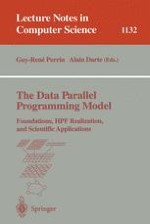This monograph-like book assembles the thorougly revised and cross-reviewed lectures given at the School on Data Parallelism, held in Les Menuires, France, in May 1996.
The book is a unique survey on the current status and future perspectives of the currently very promising and popular data parallel programming model. Much attention is paid to the style of writing and complementary coverage of the relevant issues throughout the 12 chapters. Thus these lecture notes are ideally suited for advanced courses or self-instruction on data parallel programming. Furthermore, the book is indispensable reading for anybody doing research in data parallel programming and related areas.
